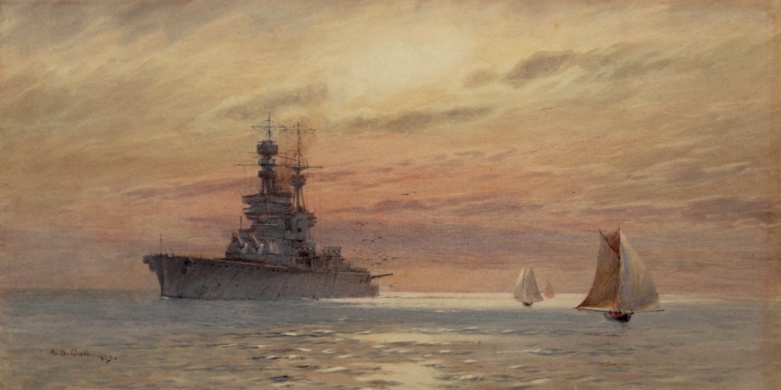HMS COURAGEOUS
Alma Claude Burlton Cull (1880-1931). watercolour signed and dated 1923 (lower left).
20 x 10 inches (51.5 x 25.5 cms) approx
Price on application
This original has been sold and is no longer available.
Cull has shown us a last glimpse of the beautiful lines of this controversial battle cruiser before she was taken in hand for conversion into an ungainly looking aircraft carrier. As usual he has painted a wonderful sky and sea with delicate colours and marvellous lighting and shadows: the ketches ghosting along up her port side are a further bonus!
In 1915 the First Sea Lord, Admiral Sir John Fisher, ordered that two battleships who were languishing on the drawing board be redesigned as fast battle cruisers: RENOWN and REPULSE were, he stated emphatically, to be completed within 15 months although, in the event, they overran by some 5 months, still a pretty amazing achievement. Having got the building of these two ships underway the energetic First Sea Lord went further and in great secrecy - because they were unfunded - he ordered a further three fast battle cruisers, COURAGEOUS, GLORIOUS and FURIOUS. The first two were to be capable of 32 knots and to carry only four 15 inch guns because with the shallow draft Fisher demanded (necessary for his beloved "Baltic Project) hull shell plating was thin and both armament and armour had to be severely pruned as well. FURIOUS was to mount two 18 inch guns but some sort of sense prevailed and she finally entered operational service with only one. Fisher referred to them as "large light cruisers": to the lads they were OUTRAGEOUS, UPROARIOUS and SPURIOUS when the huge ships (they were some 150 feet longer overall than the Queen Elizabeths) arrived with the Grand Fleet in 1917 patently under armoured and underarmed! The Grand Fleet Commander did not find it easy to employ these ships and for a while COURAGEOUS acted as a fast minelayer; after the war she was attached to the gunnery school at Portsmouth.
The Washington Treaty saved the trio's bacon. Required to reduce her battleship tonnage, Britain was however allowed to build up aircraft carrier tonnage and so it was that all three were taken in hand for conversion to aircraft carriers, COURAGEOUS emerging in 1928. She performed valuable service in the ten years remaining before World War 2, years in which the Royal Navy fought to regain control of its air arm which had been made over to the new Royal Air Force when it was formed in 1918. She finally met her end on 17 September 1939 when she was torpedoed by a German submarine.
